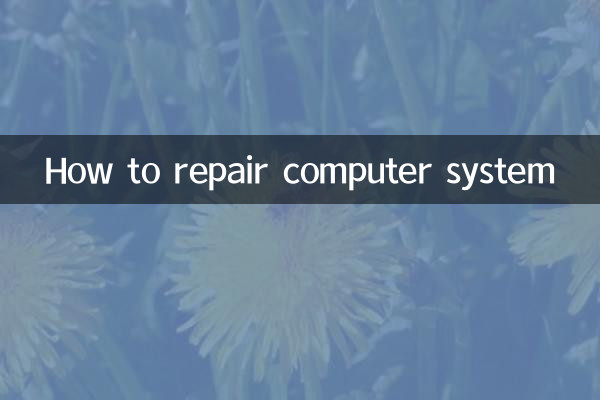How to repair computer system
In today's digital age, computer system crashes or problems are a common problem for many users. Whether due to a virus infection, hardware failure or corrupted system files, repairing a computer system is a skill that every user needs to master. This article will provide you with hot topics and hot content on the Internet in the past 10 days, combined with structured data, to introduce in detail how to repair computer systems.
1. Common computer system problems and their causes

Based on recent popular discussions, here are the most common computer system problems users encounter and their possible causes:
| Question type | Possible reasons | Frequency of occurrence (last 10 days) |
|---|---|---|
| System blue screen | Driver conflicts, hardware failures, memory problems | high frequency |
| System freezes | Too many background programs, hard disk fragmentation, viruses | extremely high |
| Unable to start | System file corruption, hard disk failure | IF |
| Application crashes | Compatibility issues, system update conflicts | high frequency |
2. Common methods for computer system repair
In response to the above problems, the following are the most discussed repair methods by users on the entire network in the past 10 days:
1. Use system restore points
If your computer system suddenly encounters a problem, you can try using a system restore point to restore the system to its previous state. This is a built-in function of Windows system. The operation steps are as follows:
- Open Control Panel > System and Security > System > System Protection.
- Select "System Restore" and follow the wizard to select a restore point.
- Restart the computer and check if the problem is resolved.
2. Run the System File Checker (SFC)
Corrupted system files are a common cause of many problems. Windows provides the SFC tool, which can scan and repair damaged system files:
- Open command prompt as administrator.
- Enter commandsfc /scannowand press Enter.
- Wait for the scan to complete and the system will automatically repair the damaged files.
3. Reinstall the system
If other methods fail, reinstalling the system may be the last solution. In the past 10 days, many users have shared their experience of reinstalling the system:
- Back up important data.
- Use a USB flash drive or CD to create system installation media.
- Follow the installation wizard to complete system reinstallation.
3. Recommended popular repair tools
The following are system repair tools that have been highly discussed by users recently:
| Tool name | Function | Applicable system |
|---|---|---|
| Windows Repair Assistant | Automatically detect and fix system problems | Windows 10/11 |
| CCleaner | Clean junk files and repair registry | Windows/macOS |
| Macrium Reflect | System backup and recovery | Windows |
| Boot Repair Disk | Fix startup issues | Linux |
4. Suggestions for preventing system problems
In order to avoid computer system problems, the following are preventive measures commonly recommended by experts and users in the past 10 days:
-Update the system regularly: Make sure the operating system and drivers are up to date.
-Install anti-virus software: Prevent viruses and malware from damaging your system.
-Clean disk: Delete unnecessary files regularly to avoid running out of hard drive space.
-Create system backup: Use tools like Macrium Reflect to back up your system regularly.
5. Summary
Computer system repair is a complex but necessary process. With the methods and tools introduced in this article, you can effectively solve most system problems. If the problem persists, it is recommended to contact professional technicians or brand after-sales support. Keeping your system healthy will make your computer run smoother and safer.

check the details

check the details